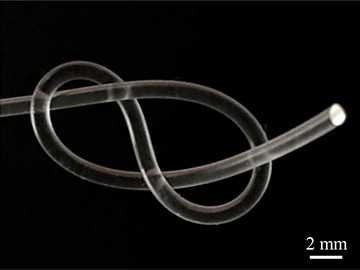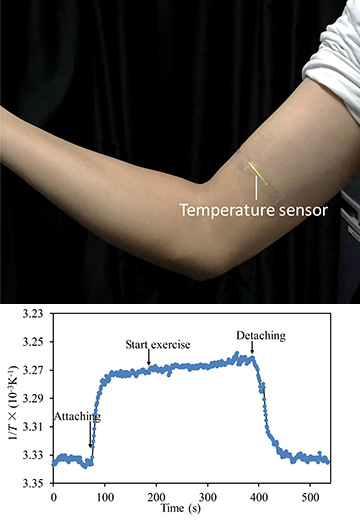
The elastomer used as a foundation for the Tsinghua’s team’s fiber optic temperature sensor is sufficiently flexible to be tied into knots. [Image: Courtesy of J. Guo]
Researchers at China’s Tsinghua University have demonstrated a flexible, stretchable optical fiber that uses light signals from embedded upconversion nanoparticles to act as a biocompatible temperature sensor (Adv. Funct. Mater., doi: 10.1002/adfm.201902898). The team believes that the fiber could offer an interesting platform for the development of real-time wearable temperature sensors for personal health care, as well as for applications in robotics.
The need to bend
To be practical, wearable sensors need to be sufficiently flexible to bend and stretch with the twists and turns of their human wearers. The development of such supple materials for wearable temperature sensors has already made a fair amount of progress in the electronic realm, with research teams looking at various mechanically flexible nanomaterials such as carbon nanotubes and polymer composites.
But the Tsinghua University researchers note that such materials tend to include metal components that reduce their biocompatibility—and whose effectiveness in the real world might be compromised by electromagnetic interference. Optical fiber offers a possible alternative that can overcome some of these problems. Yet conventional fibers, made of silica or glass, fall short on the flexibility requirement.
Elastomer fiber
The Tsinghua team, led by research fellow Jingjing Guo and OSA member Lingjie Kong, wanted to see if it could devise a temperature-sensitive fiber that could stand up to the mechanical demands of wearable technology. To do so, they built on recently published work by Guo and colleagues in the lab of OSA member and coauthor Changxi Yang.
In that work, the group used the highly stretchable silicone elastomer polydimethylsiloxane (PDMS) to fashion an optical fiber that could withstand strains on the order of 100%. The researchers further demonstrated that this flexible fiber could serve as a wearable strain or motion sensor, through readings of changes in the attenuation spectrum of white light sent through the fiber.
UCNP thermometers
To turn that fiber into a temperature sensor, the team went to the chemistry lab. They began by synthesizing core–shell upconversion nanoparticles (UCNPs) that could serve as tiny thermometers embedded in the elastomer fiber core.
UCNPs are nanoparticles that, through an anti-Stokes emission process, absorb two or more low-energy photons and re-emit a single photon at a higher energy (shorter wavelength). It turns out that for UCNPs consisting of a core of NaYF4:Yb,Er, the emission is highly sensitive to temperature shifts (probably owing to thermal coupling of several key erbium energy states).
The team cooked up a batch of these NaYF4:Yb,Er nanoparticles, coated in a thin shell of NaYF4 to protect the particle core from nonradiative decay and maximize the upconversion output. They then used the UCNPs to dope a precursor of high-refractive-index PDMS polymer, molded the doped PDMS into a fiber core, and coated the core in a lower-refractive-index PDMS cladding for confinement of light in the core.
Sensitive to 0.3 °C shifts

In one of the team’s tests, the researchers affixed the UCNP-doped fiber to a volunteer’s arm and measured temperature changes during a three-minute dumbbell exercise. [Image: Courtesy of J. Guo]
The researchers tested the fiber by coupling a near-infrared (NIR), 980-nm laser to one end of the fiber to excite the embedded UCNPs, and using a spectrometer at the other end to measure spectral changes at different temperatures. They found that the sensors could accurately detect temperature changes as small as 0.3 °C, across a temperature range of 25–70 °C. Of particular relevance to wearables, the team noted that the temperature readings remained robust under applied strains as great as 80%. The researchers even demonstrated the fiber sensor in action in measurements of skin, mouth and nose-breathing temperature.
The researchers acknowledge a few possible hurdles on the road to a real-world wearable system. In particular, the current setup requires use of a portable spectrometer for reading out the results, which the team writes “might be rather bulky for practical applications.” That shortfall could, the researchers suggest, be overcome by systems integrating narrow-bandwidth optical filters and more diminutive photodiodes for detection.
The team concludes that its UCNP-doped fibers offer “a promising optical strategy for the design of next-generation monitoring devices,” with potential uses in personalized health care, human–machine interfaces and robotics.
